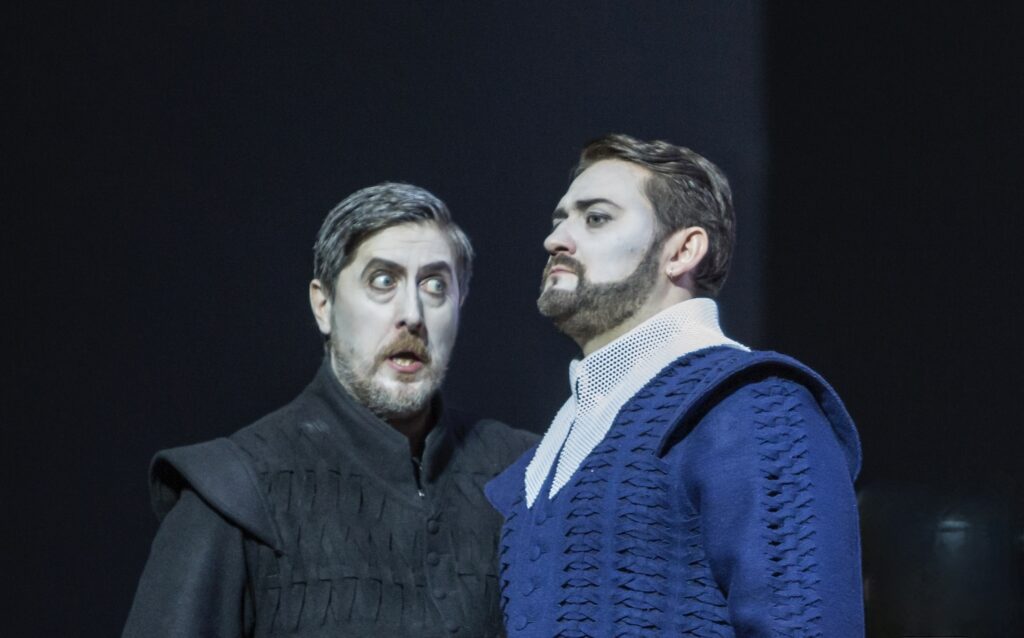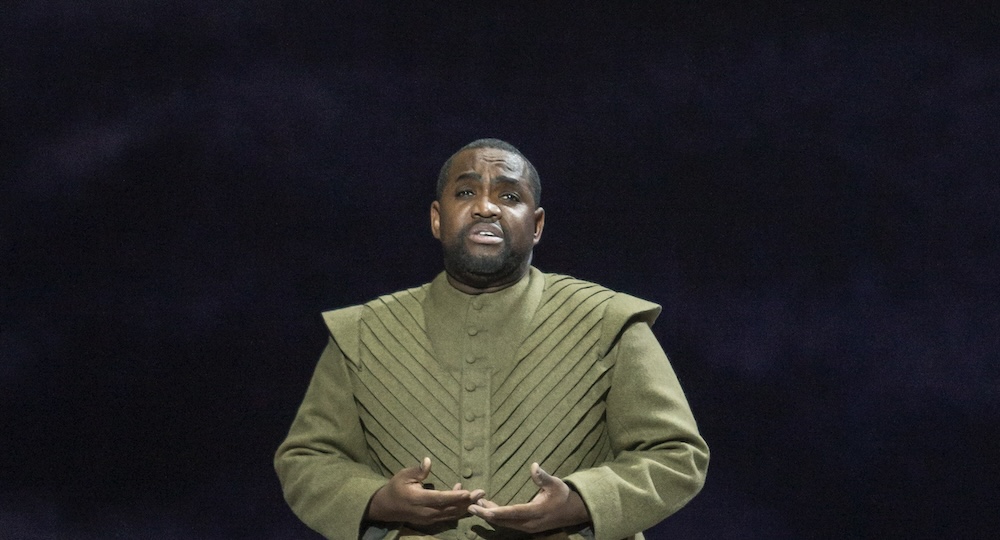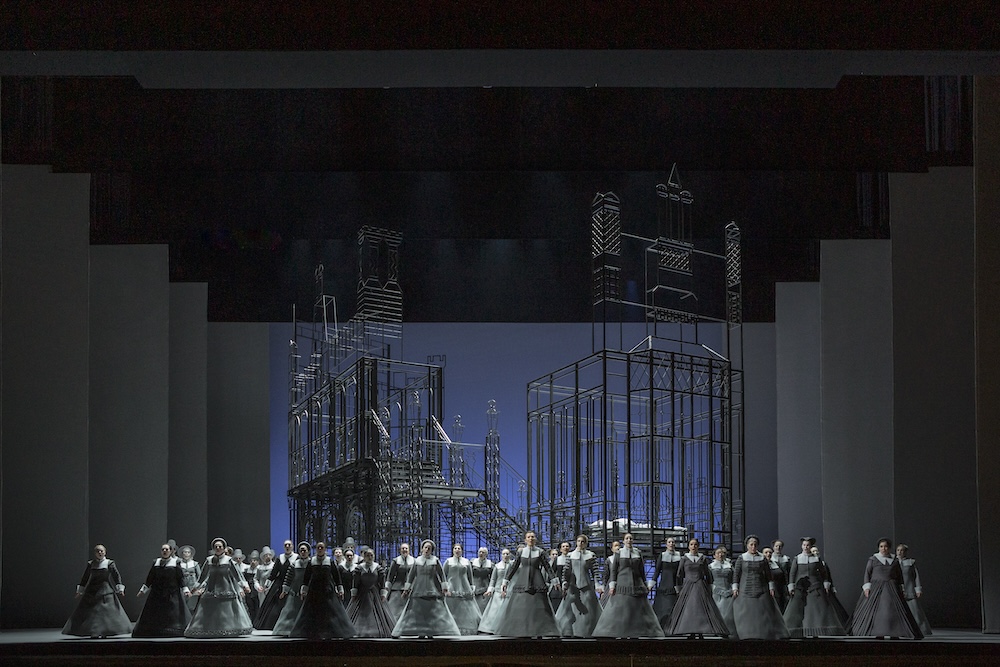Bellini’s tenth and last opera, I Puritani, took Paris by storm in 1835. Judging from the wild applause and standing ovation just now, it has lost none of its appeal for Parisians.
The thirty-three year old composer [he died the next year] was very much in the contemporary literary currents of his time. His choice of librettos plumbed the depths of mysterious and exotic atmospheres, including those of the mind. The crowning glory of I Puritani is its mad scene, the domaine of storied sopranos (notably Maria Callas and Joan Sutherland) essentially bringing the pastorale in its Rococo extensions and Baroque splendor to the newly exploited intimacies of Romantic sensibilities.
The diva for this third edition of Laurent Pelly 2013 Opéra Bastille production is New Orleans soprano Lisette Oropesa, a 41 year old coloratura soprano of evident excellent technique, and a charming, athletic presence. This positive energy however over-shadowed the confused spirit of a Romantic heroine, torn by the obligations to her father, the Puritan Lord Walton, that contrasted with those of her heart, the royalist Arturo, and then truly torn up when her true love abandoned her,.
Mme. Oropesa vocally dashed off the mad scene with ease (lead photo). She did not project its anguish, nor did she transmit her sheer pleasure in having sung such a fine performance. This was in fact the over-riding impression of the evening.
Her role, Elvira, was not the only one to suffer the torments of love. Riccardo, sung by Ukrainian baritone Andrei Kymach, was the fiancé intended by Elvira’s father, Lord Walton. Riccardo loved Elvira very much, but Mr. Kymach’s opening lament, “Per sempre, per sempre io ti perdei” failed to set a rewarding bel canto standard for the evening. though he did pull off a spirited “Suoni la tromba” that ends Act II, a piece that puzzles critics for its un-Bellini like tone.

American tenor Lawrence Brownlee however was a true voiced Romantic hero. Torn by his love for the Puritan Elvira and his respect and responsibility for the fleeing Royalist queen, he found the real bel canto, exuding his pleasure in beautiful singing, enchanting us with his third act troubadour song “Corre a valle, corre a monte,” thrilling us with his high F (“crudeli, crudeli”) in the Act III finale. Mr. Brownlee is of quite beautiful voice, though it was notably smaller than the other voices on the stage. His signature role in Paris is certainly the title role in Rameau’s Platée.

Italian baritone Roberto Tagliavini portrayed Elvira’s uncle Giorgio, from whom she elicits a true paternal affection. Of exceptionally beautiful voice Mr. Tagliavini communicated a dignity and warmth that musically grounded this dramatically superfluous character, giving him some reason, at least, to exist — the Puritani libretto is famously among the repertoire’s more obtuse.
Note that the opera’s happy ending (Elvira, sane again, marries Arturo) was effected by a letter from Oliver Cromwell, exonerating all Royalists, but limited in I Puritani to exonerating only the queen Enrichetta di Francia and Elvira’s lover Arturo.
The cast was completed by members of the Troupe Lyrique de l”Opéra national de Paris (essentially the Opéra’s apprentice program): Enrichetta was sung by Netherland mezzo soprano Maria Warenberg, Elvira’s father Lord Dalton was sung by Canadian bass baritone Vartan Gabriellan, and Sir Bruno (Riccardo’s confident) was sung by Tongan tenor Manase Latu.
Unfortunately Italian conductor Corrado Rovaris could not feel, nor did he attempt to find the exquisite beauty of line that defines the Bellini style. The maestro, buried in the score, remained isolated from stage, providing only a rigid beat, eliciting few orchestral colors, sabotaging the valiant attempts at bel canto on the stage, particularly those of the diva.
The Pelly production uses the full width of the Opéra Bastille’s stage, and maybe its depth as well — a strange space for the musical and dramatic intimacies of bel canto. Working with his long time design collaborator Chantal Thomas he created a massive, constantly revolving, thin lined 3 dimensional abstracted diagram of a castle and keep that transformed itself into intimate spaces at appropriate moments. Such a grand, open space was effective for the large scenes with chorus — the Opéra national de Paris providing an excessive number of choristers to fill the stage. When alone on the stage, the principals seemed lost in all that open space.

Pelly pressed the identically dressed choristers into variously shaped geometric blocks that moved around the stage as these fixed shapes. Such abstracted movement clashed with the more natural movements of the principles, and particularly clashed with the highly detailed, energetic movements of Mme. Oropesa. The staging was perhaps more effective in the earlier editions of this Pelly production.
It was a critically frustrating evening, though greatly appreciated by an enthusiastic audience.
Michael Milenski
Opéra Bastille, Paris, France, February 12, 2025
All photos copyright Sébastian Mathé, courtesy of the Opéra national de Paris